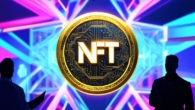
How can you create your own NFT
NFTs, or non-fungible tokens, have become increasingly popular in recent years, especially in the art and collectibles markets. An NFT is a unique digital asset that represents ownership of a specific item, such as an artwork, music track, or video game in-game item. In this article, we will explore how to create your own NFT, including the necessary tools, steps, and considerations for success.
1. Understand NFTs:
Before diving into the process of creating your own NFT, it’s important to have a solid understanding of what NFTs are and how they work. Essentially, an NFT is a digital asset that is stored on a blockchain network, which provides transparency, security, and immutability for the asset.
To create an NFT, you will need to follow these basic steps:
-
Choose your NFT type: There are various types of NFTs, including art, music, video, and even domain names. You should choose a type that aligns with your interests or business goals.
-
Create your digital asset: Your NFT will represent ownership of this digital asset, so you’ll need to create it first. This could involve creating artwork, writing music, or developing a game asset.
-
Tokenize your asset: Once you have your digital asset, you’ll need to tokenize it on a blockchain network. There are several platforms available for this, such as OpenSea, Rarible, and SuperRare. Each platform has its own unique features and pricing structures.
1. Choose Your NFT Type:
As mentioned earlier, there are various types of NFTs to choose from. Here are some examples:
-
Art: This is one of the most popular NFT types, with artists selling their digital paintings and drawings as NFTs on platforms like OpenSea and Rarible.
-
Music: You can create an NFT that represents ownership of a specific music track or album. This could be particularly useful for independent musicians who want to monetize their work directly with fans.
-
Video: If you’re a content creator, you can use NFTs to sell access to your videos or other video content.
-
Domain names: Some platforms allow you to tokenize domain names as NFTs, which can be particularly useful for creators who want to monetize their online presence.
1. Create Your Digital Asset:
Once you’ve chosen your NFT type, it’s time to create your digital asset. Here are some tips to help you get started:
-
Keep your asset unique: NFTs are all about uniqueness and ownership, so make sure your asset is truly unique and valuable.
-
Consider the quality of your asset: Your digital asset should be high-quality and professional-grade. This will help it stand out from other NFTs and increase its value.
-
Make sure your asset is easily replicable: While uniqueness is important, you’ll also need to ensure that your asset can be easily replicated by others if needed. This could involve creating a template or providing instructions for how to create similar assets.

1. Tokenize Your Asset on a Blockchain Network:
Once you have your digital asset ready, it’s time to tokenize it on a blockchain network. Here are some popular platforms to consider:
-
OpenSea: This is one of the largest and most well-known NFT marketplaces, with a wide range of tools and features for creating and selling NFTs.
-
Rarible: Another popular platform for creating and selling NFTs, with a focus on art and creative industries.
-
SuperRare: This is a niche platform that specializes in rare and limited-edition digital assets, including art and collectibles.
1. When choosing a platform, consider the following factors:
* Fees: Each platform charges different fees for creating and selling NFTs, so it’s important to compare prices before making a decision.
* Audience: Consider the demographics of the platform’s user base and whether it aligns with your target audience.
* Features: Different platforms offer different features and tools, such as customizable metadata and royalty payments.
1. Market Your NFT:
Once you’ve created and sold your NFT, it’s important to market it effectively to increase its value and attract potential buyers. Here are some tips to help you promote your NFT:
-
Utilize social media: Social media is a powerful tool for promoting NFTs, so make sure to create a presence on platforms like Instagram, Twitter, and Discord where your target audience is active.
-
Collaborate with other creators: Partnering with other creators or influencers can help you reach new audiences and increase the visibility of your NFT.
-
Offer exclusive perks: Consider offering exclusive perks or access to your NFT, such as behind-the-scenes content or personalized messages from the creator.
1. FAQs:
Here are some common questions about creating and selling NFTs:
-
Can I create an NFT without owning the copyright to the digital asset? No, you will need to have ownership of the digital asset in order to create and sell an NFT.
-
How do I determine the value of my NFT? The value of your NFT will depend on various factors, such as its rarity, uniqueness, and demand from buyers. You can use tools like OpenSea’s marketplace data to get a sense of what other NFTs in your category are selling for.
-
Can I sell my NFT on multiple platforms? Yes, you can list your NFT on multiple platforms to increase its visibility and reach potential buyers.
-
How do I set royalty payments for my NFT? Most NFT marketplaces allow you to set a percentage of the sale price that goes directly to you as the creator. You can also set specific conditions or events that trigger royalty payments, such as when the NFT is resold.
1. Summary:
Creating and selling an NFT can be a rewarding experience for artists, musicians, and other content creators who want to monetize their work directly with fans. By following the steps outlined in this guide and considering the tips and best practices discussed, you can increase your chances of success and create a valuable digital asset that stands out from the competition.
In conclusion, creating an NFT is an exciting opportunity for creators to monetize their work and connect with fans on a deeper level. With the right tools, strategies, and mindset, you can create a successful NFT that resonates with your target audience and helps you achieve your business goals.







